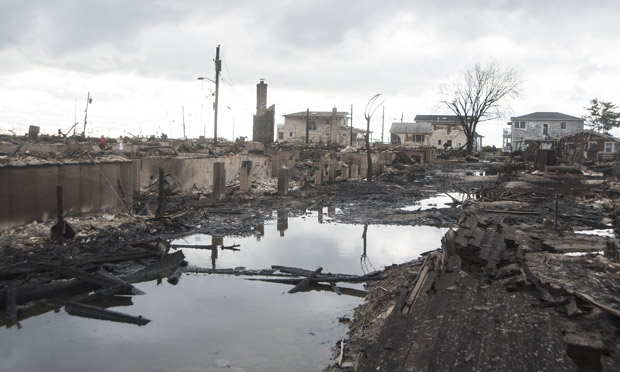Beyond the first world, Sandy devastated some parts of the Caribbean before landing on the US: Haiti (54 dead), Guatemala (52 dead and 20 missing, coinciding with an earthquake), Cuba, Dominican Republic (2 deaths), Jamaica and Bahamas (here without any dead fortunately).
The presidential campaign itself (Obama and Romney mentioned it) and the press in general (it's global warming, stupid) suggested the relationship between Sandy and global warming. But is there really a relation in this kind of events?
First of all, why was Sandy so devastating? For the simple reason that it was a huge hurricane. It started as a tropical storm originated in the warm Caribbean in front of Venezuela. As it moved northward, Sandy was fed by the unusually warm waters of the Atlantic. Gradually, it was increasing the intensity of showers and thunderstorms until Sandy ran into a very cold front coming from Canada and became a hurricane superstorm with 1900 km in diameter and winds over 120 km / h (up to 280 km / h in the storm center).
But is this normal? Well... Normally these storms dissipate on the Atlantic Ocean but in this case, a rare high pressure system over Greenland (due to an abnormal warming), lead Sandy to the east coast of the US. This way, due to the collision between a warm storm with a cold system over the US, Sandy became a very strange monster: a snowing tropical hurricane. If we add the contribution of the full moon during those days (nothing to do with werewolves), which raises tides above average, we already have our extreme scenario.
 |
| Destruction caused by Hurricane Sandy in Breezy Point, New York. Photograph: Julie Hau |
Although, basically, that would not matter if we believe what George Lakoff (the famous linguist author of "Do not think of an elephant" (what are you thinking now?)) points: Through the term "systemic causality" Lakoff explains how sometimes we put the entire guilt on elements affecting something only partially, like if they were totally responsible for its whole. For example, Lakoff cites "smoking causes lung cancer". Well, it's smoking and more things right? It doesn't matter: smoking systemically causes lung cancer. For Lakoff, the same happens with climate change and Sandy and I think it makes sense.
Being objective, in meteorology, frequency is even more important than intensity. So will there be more extreme weather events due to climate change? The answer is "YES, definitely". On a previous post, we already discussed this expected increase in extreme weather frequencies. Andrew Cuomo, the Governor of New York: "We have a 100-year flood every two years now". And studies seem to prove him right. Grinsted et al. 2012 published in Nature an article where it was shown that the number of major storms has increased in frequency since 1923; indeed, they detected that extreme events are about twice more likely during warm years than during cold ones.
Now think about this 2012 summer and the episode of abnormal Arctic Ice loss. In principle, these warmer freshwater could alter the flow of the jet stream around the northern hemisphere leading to an increase of water temperature in the North Atlantic water. Will this have any relation with Irene, Sandy and the massive winter storms that have been hitting the US Northeast in recent years?
There is also an expected sea level rise due to global warming. Lin et al. 2012 indicated that the combined effects of this new climate and an increase of 1 meter in the sea levels could mean that 100 years ago extreme events occur between every 3 and 20 years ... in New York !!! In other words, we should expect a "Sandy" every 3-20 years and that doesn't mean that the next will come in 19 years...
Besides, the American northwest coast is full of small bays, inlets, lowlands etc which means that it is very vulnerable.
Can you imagine the economic and environmental costs of protecting all this area with dikes? They did something similar in Louisiana to try to contain the Bp's oil spill in 2009. Setting up a (terrible) sand dike of around 70 kilometers long costed $360 million. The cost is low to save human lives but ... can we not spend it on something else? Because if you don't care about weather, let's talk about money.
%2B17.31.39.png)
No comments:
Post a Comment